Returning to Perth after a recent wildlife watching trip I was reaccquainted with the wide open spaces of the interior of the state. Now that the searing Summer temperatures in that part of the world were on the wane, diurnal reptiles start to once again appear. So it was with sadness I came across a Thorny Devil fallen victim to vehicle strike. The habitat looked excellent so I decided to return to see if I could find a live Thorny Devil before the onset of cooler mid-year temperatures.
Thorny Devils are a species most often associated with sandy country. They occur over the Western two thirds of the Australian continent from the Northwest of Western Australia, through the Southern half of the Northern Territory, South Australia and as far as the West of Queensland.
The activity of this species is biannual. The first period of activity, from August to November is when mating and egg-laying occurs, followed by a period of inactivity during the hottest Australian months of December – February. The second period of activity is over Autumn covering March – May, after which brumation occurs during the coldest months of June and July.
March 12th-14th.
My partner Lorenz, disappointed after scanning the roads unsucessfully for Thorny Devils on a return drive from the Kimberley in 2018, accompanied me in the hope of a sighting, and so on a March weekend we set off from Perth on the long, straight country roads. A recent cold front had passed over the Southwest of the state resulting in cool mornings, but by Saturday afternoon temps were in the low 20’s and a few Southern Heath Monitors had ventured out onto the tarmac from the roadside vegetation to bask.
As we approached the tiny town of Pingrup, the stand-out landmark are the wheat silos, visible from ten kilometres away in the flat, salt lake country. These silos are part of the Western Australian Silo Art Trail see link :- PUBLIC Silo Trail | Discover WA’s largest outdoor art gallery The immense silo art was impressive and depicted life in this small farming community.
Silo Art Trail – Pingrup.

As the afternoon wore on temperatures began to fall and with reptiles now an outside chance we headed towards the town where accommodation was booked for the night. In the Wheatbelt the original vegetation has been mostly cleared, but in some shires wide strips of remnant vegetation run alongside the roads.
It was off the road and into a strip of remnant vegetation that we observed a large turkey-sized, and beautifully patterned bird. Surely not, it couldn’t be? But indeed it was. A Malleefowl! This was a bird that I had always hoped to, but never seen in the wild.

Malleefowl are a birds of the megapode family which incubate their eggs in a self-built mound, in the case of Malleefowl measuring as high as 1.6m and 5m across, truly impressive structures for a turkey-sized bird.
The mound is built by both sexes, then in mid-winter it is opened up and organic matter placed into the centre. This decaying organic matter provides the heat necessary to incubate the 8-30 eggs which are layed late September. Both birds then control the temperature of the mound by adding and removing sand to keep the temperature a constant 32-34C until the chicks hatch. In the course of a season a pair of malleefowl can move literally tons of earth!
Unfortunately, the bird disappeared into the vegetation before I could get out my camera, but further along there was a second bird, then a third…….
Malleefowl.
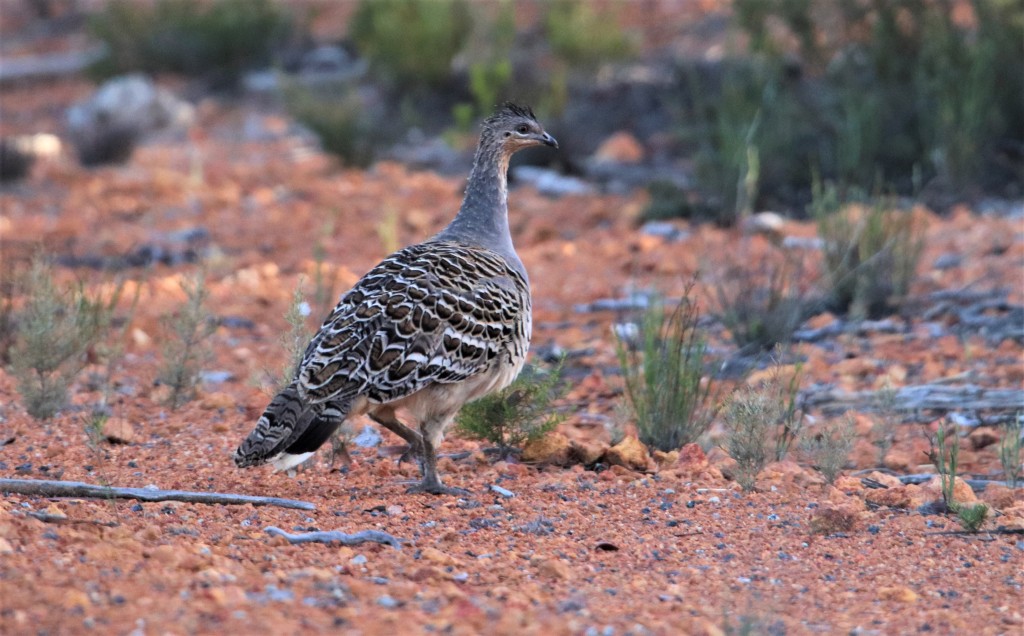
……..until over the course of ninety minutes a total of eleven Malleefowl were seen! It seems that these birds were attracted to the road by grain spilt from trucks transporting this important West Australian export. What a pleasant and surreal end to a long day on the road.
Malleefowl.
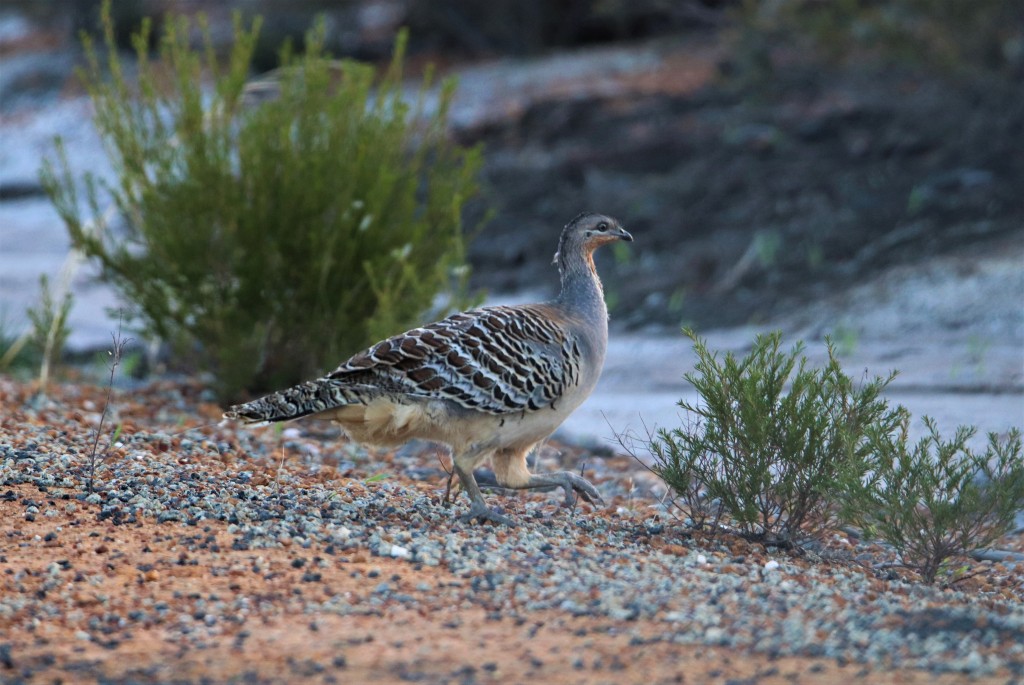
We overnighted in a small town, with a charming and lively tavern serving excellent food. Sunday morning we awoke to an especially cool start to the day for the time of year, with overnight temperatures dipping to 11C, this meant a leisurely start to the day as we waited for the mercury to climb.
We were on the road by 9am, and by 9.45am we encountered the first reptile of the day, a Bobtail Lizard warming on the tarmac. Although this road was not busy, it seemed best to move the Bobtail to a safer basking spot at the side of the road. Despite the cool temps this lizard was feisty indeed and didn’t take kindly to being disturbed from sunbathing. At our approach, it displayed a bluff typical of the species, hissing and opening its mouth to display the blue tongue for which receives it’s other name of Bluetongue Lizard.
Bluetongue Lizard in defensive pose.

In the event we didn’t need to unnecessarily handle the lizard, because indignant at the intrusion it sidled of the road into the surrounding bush. These common, slow moving lizards are prone to vehicle strike, and their carcasses litter the highways of Australia during the warmer months.
Fortunately, despite huge areas of the Wheatbelt being cleared for agriculture, small patches of bush have remained intact, and it is these important bush blocks that provide habitat for the remaining wildlife.
Driving one of these blocks we encountered a second reptile species, this time a Southern Heath Monitor, although this large sun-warmed varanid quickly shot off into the bush on our approach.
The continued search for a Thorny Devil took us up a sandy 4WD track where Lorenz spotted an Echidna that immediately burrowed into the ground under a bush, perceiving us as a threat.
We continued to explore the bush block and it was fortunate to have a 4WD because the terrain was rough going, in addition we had to cross a large pool of water that had formed on a low-lying part of one of the tracks, a result of recent rain.
On a track running adjacent to agricultural land we found a second Bobtail this time with darker patterning.
Bobtail Lizard.

Continuing along this track and rounding a corner, Lorenz’s eagle eyes picked up a basking Thorny Devil in the middle of the track. Even though Lorenz had never seen this species before they are quite unmistakable, patterned in a yellow, fawn and rich-reddish brown and covered in spines, including a particularly large pair of curved horns of the head, quite unlike any other Australian agamid lizards.
They are slow-moving lizards, but this little lizard was not going anywhere, intent on soaking up the suns rays now that the day had warmed, tail pointing skywards in the classic pose of this species.
Thorny Devil.
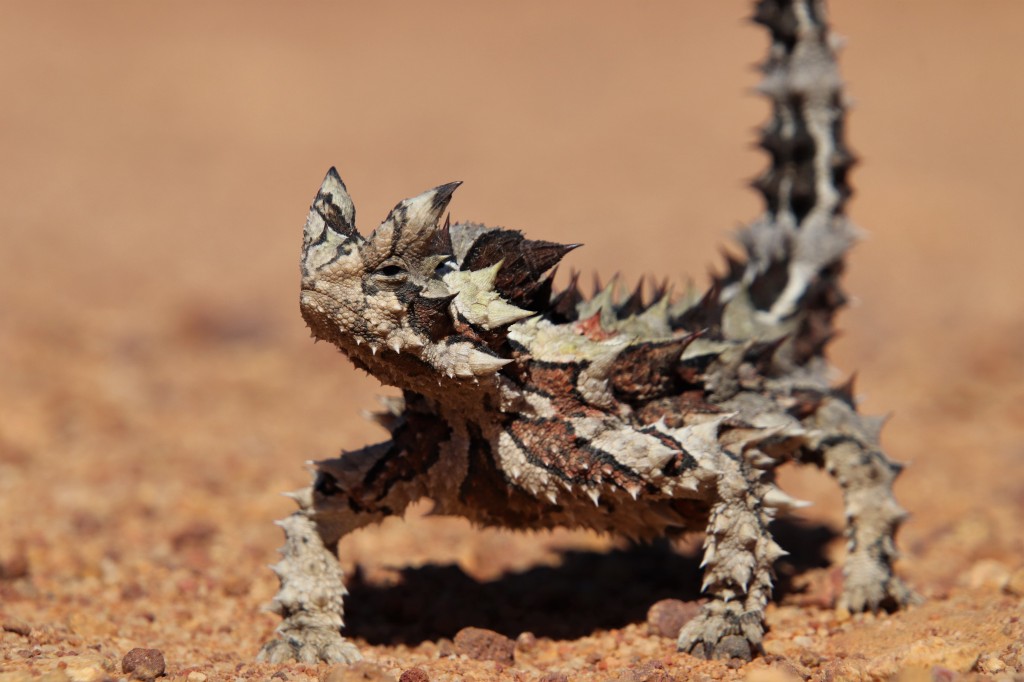
Despite their fearsome appearance (I actually think they are super cute!) their diet consists solely of ants. They are stealth predators, positioning themselves immobile alongside an ant trail to snap up passing ants.
It was clear in order to drive past we were going to have to remove this lizard off the track, providing a photo opportunity as Lorenz did the honours.
This photo shows another defence the Thorny Devil has against predators whereby it lowers its head and presents a false head of thorny tissue on the back of the neck in place of the real head.
Lorenz moving a Thorny Devil Lizard off the 4WD track.
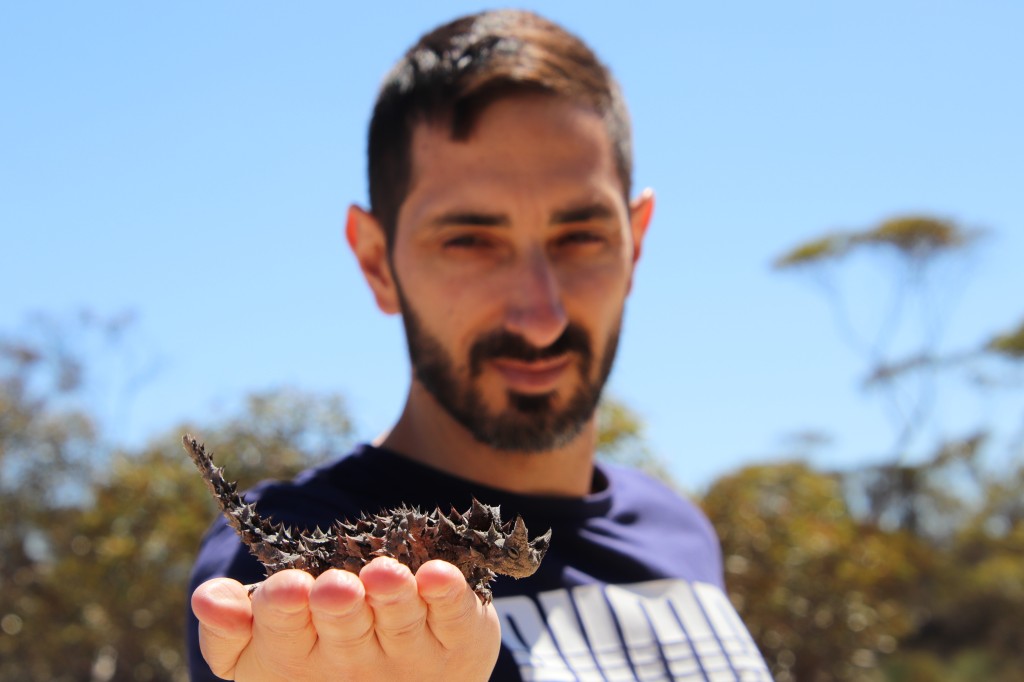
With the Thorny Devil safely off the track we continued along, and no sooner had we passed the next corner when we encountered a second basking Thorny Devil on the track!
The colouration of this lizard was brighter indicating it had been basking for longer and was therefore warmer than the previous individual. Colour change in a Thorny Devil is not only in response to temperature, they can also change colour long term to blend into their surrounds.
Basking Thorny Devil.

Time was not on our side if we were to make it back to Perth before dark, and so after a few pics we pressed on. Unbelievably within ten kilometres we had picked up a further two Thorny Devils, although we didn’t stop. Clearly this area was excellent habitat for the species.
The final reptile of the day was also basking immobile in the middle of a track as we flew by at full speed.
Despite my doubts, the Bearded Dragon, for that is what it was, remained in exactly the same position as we u-turned back.
Bearded Dragon.

Even as another car sped past, the Bearded Dragon remained immobile, allowing close approach until I was almost on top of it! This was not going to end well if it continued to bask on the road, so I stomped my foot and it scarpered into the scrub quickly disappearing under a bush.
Bearded Dragon.

It had been a remarkable morning for reptiles with four species seen in 3 hours, including the four Thorny Devils. This was certainly due to favourable weather conditions, being the first warm day after the recent cold front had passed through the area. Was this just a fluke or was this area consistenly good for Thorny Devils, I intended to find out when I returned two weeks hence.
26th-28th March
A fortnight later I was back in the big vistas of the Wheatbelt, this time solo, to see if I could recapture the Thorny Devil magic of two weeks previous. Traffic carnage leaving the city meant I was unable to get to where I had originally planned to camp, so I bush camped the Friday night next to one of the many salt lakes that are dotted throughout the Wheatbelt.
It was a cool night, but this meant I got to experience a still, crisp sunrise over the nearby salt lake. Despite the deceptive chill in the dawn the day was forcast to be warm.
Salt Lake Sunrise.

After packing up the tent, picking up breakfast at a nearby town, and punching out many more kilometres, I was back at the area visited two weeks previous. Temperatures were approaching 30C and I wondered if it was too late to find any basking Thorny Devils that morning.
I needn’t have worried, because standing astride a sandhill in the middle of a track was a Thorny Devil, looking for all the world like a king of the castle. I suspect it had been feeding on the nearby ant trail prior to my arrival, and occasionally a wayward ant would crawl over the devil causing it to close it’s eyes, obviouly the eyes of the Thorny Devil are the achilles heel in that suit of spiky armour.
Thorny Devil.

Driving around, there were patches of heath dotted throughout the area, and although Autumn is a lean time of year for flowering plants there was one species of banksia that was in the peak of its flowering period. Banksia sphaerocarpa or the Round-fruited Banksia must be an important source of nectar during this period.
Banksia sphaerocarpa.

As midday approached, the search for Thorny Devils was abandoned and I retreated to the paltry shade provided by a grove of she-oaks, where I erected the tent. What followed was a pleasant few hours dozing and reading until mid afternoon when the hottest part of the day had passed and the cooler late afternoon temperatures meant the Thorny Devil search could once again continue.
Within ten minutes of driving I came across the first Devil of the afternoon. This individual was lying prostrate on the track, interestingly it was in almost exactly the same location that Lorenz and I had found a Thorny Devil two weeks previously.
The second, and rather tough looking Thorny Devil of the afternoon was found shortly after, basking on the incline at the side of a gravel road. The scientific name for the Thorny Devil name is Moloch horridus. Moloch being the Canaanite deity associated with child sacrifice and horridus describing it spinous appearance, but secondarily meaning horrible. What an utter misnomer! These adorable lizards are one of the gentlest animals of the bush, unless you happen to be an ant that is!
Thorny Devil.

The fourth and final Thorny Devil of the day was a somewhat squat animal, which had choosen not only to unwisely bask in the middle of the gravel road, but in the actual tyre track in the middle of a gravel road! As I encouraged it to the side of the road, I was once again enchanted by the locomotion of this species. Their movement is very unusual, and they walk with a slow, jerky gait often freezing mid-stride, which is thought to be as a defence to confuse predators.
Thorny devil.

Back at camp for the evening, I ate and prepared for an early night. Early to bed meant early to rise, and cocooned in my warm sleeping bag I braced myself for the dawn chill, rising in time to see the colour change from the black of night to the purple, blues and yellows of the dawn sky.
Dawn breaks through the She-oak.
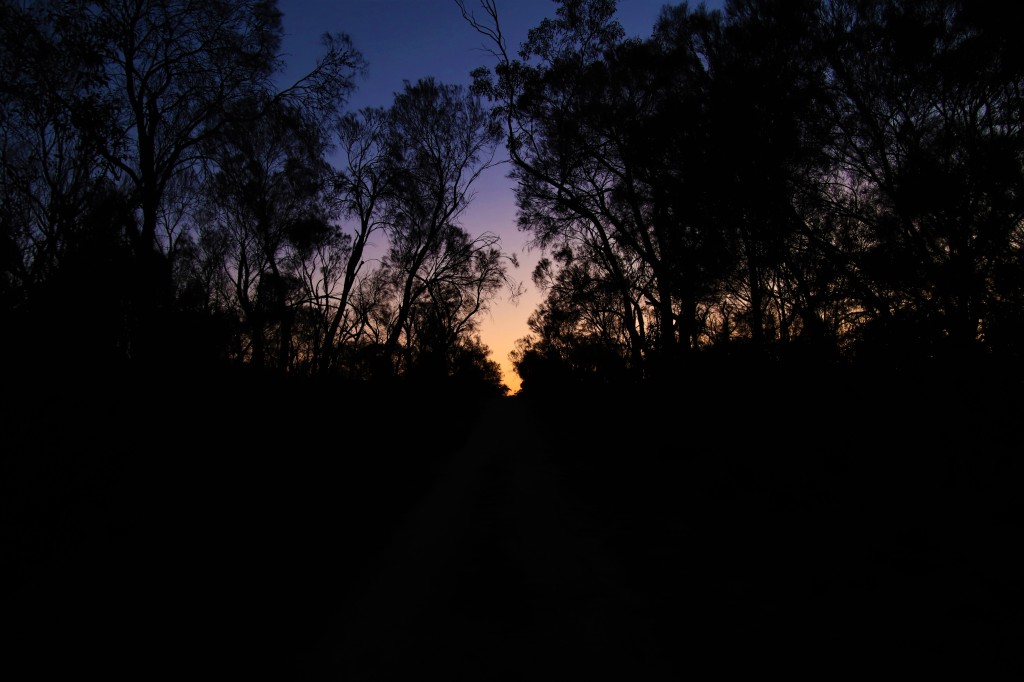
The plan for the day was an early morning exploration of the flowering heath while I waited for temperatures to rise, and then to have a short drive mid-morning to find more Thorny Devils before making the return drive to Perth.
I parked the car and started to explore the flowering heath. In common with the previous day I found plenty of Round-fruited Banksia. Then a flash of purple caught my eye. It was a Violet Banksia (banksia violacea.) This was a species I had hoped, but failed to find on a recent trip to Fitzgerald River National Park. It’s main flowering period is November to February, so I had written it off until late next Spring. There was a single flower left, the last of the season!
Violet Banksia (Banksia violacea.)

Once camp had been packed by 9.30am, the temperature were hovering around 20C and warm enough to have one last search for reptiles. The first find of the day was a sleepy Bobtail Lizard. I found my first Thorny Devil by 10am and it was in exactly the same place as one of the devils from the previous afternoon. Shortly afterwards I found a second devil, and there was no doubt that this was the same squat individual sitting in the tyre track the previous afternoon. It was once again in a tyre track! Talk about living dangerously.
Thorny Devil.

Being able to observe the same individuals several times, it would seem that Thorny Devils in common with humans are creatures of habit. Leaving their burrow to bask in the morning sun, before disappearing for the hottest part of the day. Each devil would then seem to return to almost exactly the same basking spot in the afternoon, to soak up the warmth of the afternoon sun, before temperatures fall in the evening when they return to the burrow. #QuollingAround
The below two links contain other sightings of Thorny Devils in this blog
Kimberley Adventures to Bachsten Creek and the Mitchell Plateau.
Wildlife at Dryandra – Boyagin – Tutanning Nature Reserve – 2017-2018 – Part 3 – Summer into Autumn.
Thorny Devils do not survive in captivity without a specialist diet of a few localised ant species. They slowly loose colour and starve to death. Despite it being illegal to remove Thorny Devils from the wild, there are unfortunately those people that will attempt to smuggle reptiles, for this reason I have been unusually vague and misleading regarding any locations in this record.
#QuollingAround
Just stumbled on your many outstanding blog posts Jimmy. We had planned a reptile trip from the USA to the red center this year that has been indefinitely postponed due to covid. One of the key targets for me was, of course, the thorny devil. What a magnificent lizard (I live in Arizona, so I know lizards…LOL).
Anyway, I really enjoyed this blog post and the one on numbats too (another target for a future trip). Your posts have me hooked so expect some comments coming your way. Until covid passes, I will need to live vicariously through folks like you to scratch that aussie wildlife itch.
Alan
LikeLike
Hey Alan, thanks for your kind words. Bloody covid has got a lot to answer for! Great news regarding numbats, is that numbers have been exploding at the reserves where feral cat control has been implemented. There has never been a better time than now in the last 40 years to look for this species! If you are in WA for the numbat, let me know and I can always give you a few pointers to some Thorny Devil spots. Stay Safe.
LikeLike
Thanks for the offer Jimmy. I hope to take you up on it some day.
LikeLike